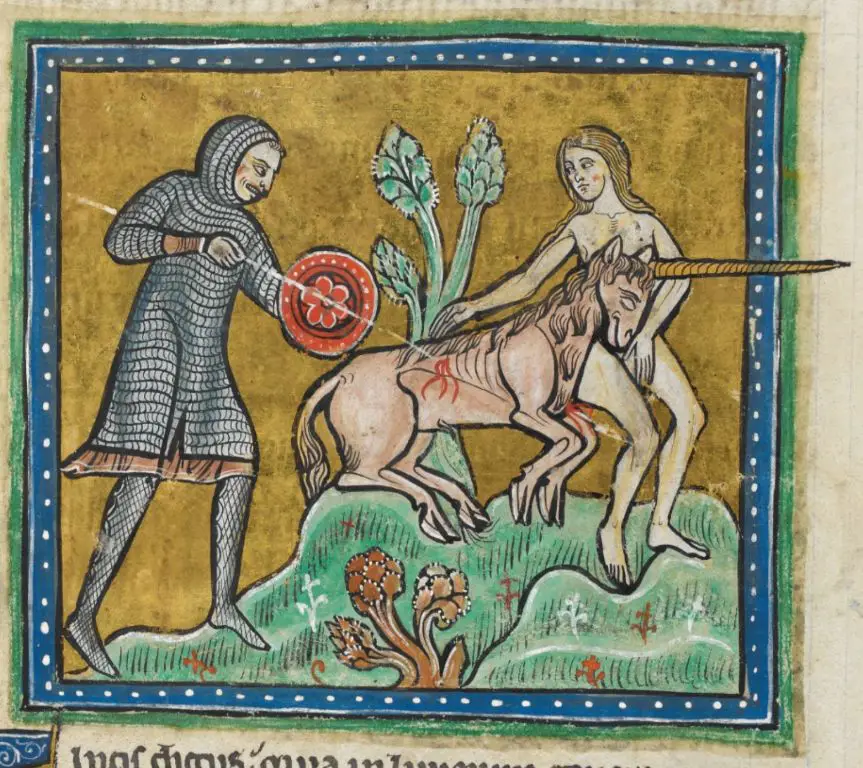What Are The Powers Of The Unicorn Horn?
Unicorns are mythical creatures that have been part of legends and folklore for thousands of years. They are most commonly described as horse-like animals with a single, straight horn protruding from their forehead. The unicorn’s horn is one of its defining features and the source of many of its mythical powers.
The earliest mentions of unicorn-like creatures come from ancient Mesopotamia and the Indus Valley as far back as 3000 BCE. These ancient cultures depicted creatures resembling unicorns in their art and myths. The unicorn also appears in early Chinese and Indian mythology. By the Middle Ages, unicorns were more widely known throughout Europe and became a symbol of purity, power, and healing.
While depictions vary, the unicorn is most commonly described as having the body of a white horse, the head of a goat, the tail of a lion, and a long horn protruding from its forehead. The unicorn’s horn is believed to possess magical abilities and healing powers, which is the main focus of the legends surrounding this mythical creature.
Healing and Purification
The unicorn’s horn has long been associated with healing powers and the ability to cure poisons or illnesses. In medieval European lore, the unicorn’s horn was believed to have purifying qualities that could detoxify liquids. According to ancient myths and legends, dipping a unicorn’s horn into poisoned water could render it drinkable again.
There are many tales of people using powdered unicorn horn to create antidotes and cure deadly poisons or illnesses. For example, an early Persian text claimed that “unicorn horns removed paralysis, epilepsy and toxins from the body” (Wikipedia). In the 16th century, German physician Johann Schott produced various medical recipes using unicorn horn as an ingredient. He believed that unicorn horn could cure plague and fevers.
In addition, unicorn horns were believed to have healing effects when directly touched to injuries or wounds. There are accounts of people being miraculously cured of injuries by the touch of a unicorn’s horn. For instance, the 12th century tale of Saint Hubert recounts how touching a unicorn horn to a poisonous snakebite on his hand instantly healed the wound.
Overall, myths and legends grant the unicorn’s horn a diverse array of healing and curative powers, from curing poisons and toxins to miraculously healing injuries and wounds.
Antidotes and Antivenoms
Unicorn horns were believed to have the power to counteract poisons and venoms. This belief stems from ancient accounts describing the unicorn’s horn as having medicinal properties as an antidote. According to ancient Greek writers like Ctesias, unicorn horns could be used to make drinking vessels that protected against poison (Unicorn horn). Throughout history, royalty and nobility would drink from goblets made from unicorn horn, believing this protected them from being poisoned.
In the 16th century, Queen Elizabeth I of England was known to drink from a unicorn horn cup, thinking that if poison touched it, the cup would shatter or explode (https://www.history.com/news/unicorn-horns-royal-protection-poison-antidote). Unicorn horns were also commonly powdered and ingested as a poison antidote both before and after consuming poison (https://recipes.hypotheses.org/511). While these beliefs seem fantastical today, they speak to the powerful legendary status of the unicorn horn as a protector and healer.
Protection and Magic
According to medieval lore and myths, unicorn horns were believed to have powerful magical properties that could protect the owner, reveal truths, and break spells or curses. Many royal families and nobles during the Middle Ages highly coveted unicorn horns, believing they could ward off poisons and keep the holder safe from harm.
In the 16th century legend, King Charles VI of France was gifted a unicorn horn that he believed protected him from poison and assassins. Unicorn horns were thought to be able to neutralize poisons, make contaminated water safe to drink, and act as an all-purpose antidote. There are tales of nobles who travelled with unicorn horns as a defence against poisoning attempts.

Additionally, unicorn horns were thought to have the power to break spells and curses. According to mythological stories, a unicorn’s horn could reveal truths and unveil illusions or deception. Some believed that gazing into the spiraling interior of the horn could induce visions and give insight into the future.
Hunting for Horns
The unicorn horn trade began as early as the 5th century BC, when the Ancient Greeks and Romans believed the spiraling horn had mystical healing abilities that could counteract poison and cure various maladies (History.com, 2019). The horns came from narwhal whales found in Arctic waters, as their long spiraling tusk was thought to come from the mythical unicorn.
The trade strengthened during the Middle Ages, when the unicorn became a symbol of Christ, and therefore an almost holy animal. By the 12th century, unicorn horns were enormously valuable, selling for ten times their weight in gold. They were used to test food and drink for poisoning, as it was believed contact with poison would cause the horn to shriek, sweat beads, or shatter (AtlasObscura.com, 2018). Apothecaries used shavings from the horn in medicines and antidotes.
As the demand grew, traders exploited the scarcity and mystique of unicorn horns. Counterfeit horns made from whale teeth, bones, and ivory tusks flooded the market. Exorbitant prices led thieves to steal horns from royal collections across Europe. Despite the fraudulent horns, belief in the healing powers of the unicorn horn persisted into the 18th century (History.com, 2019).
In Art and Literature
The unicorn horn has been depicted in art and literature for centuries across many cultures. Unicorn horns were often illustrated in medieval bestiaries, describing mythical or real animals. They were sometimes drawn spiraling like a narwhal tusk or straight like an antelope horn. Famous examples include the 12th century Rochester Bestiary, the 13th century Northumberland Bestiary, and the 16th century Nuremberg Chronicle.
Unicorn horns appeared in religious art and sculpture as well. The Virgin Mary was sometimes portrayed holding a unicorn horn in Annunciation scenes. Gothic sculptures such as the 14th century Lady and the Unicorn at the Musée de Cluny in Paris also featured unicorn horns. The horn was a symbol of purity in these Christian works.
In literature, unicorn horns were mentioned in medieval medical texts as having healing powers. They were also included in myths, legends, and stories across Europe and Asia, from Indo-European tales to the Travels of Marco Polo. The unicorn’s horn remained an iconic motif through the Renaissance and Baroque eras, represented in texts like Edmund Spenser’s The Faerie Queene and Ludovico Ariosto’s Orlando Furioso.
Modern Symbolic Meaning
The unicorn horn continues to hold deep symbolic meaning in modern culture. It remains associated with purity, protection, healing, and magic (Source). The spiraled horn represents a winding spiritual journey towards wisdom, intuition, and enlightenment. It is seen as a conduit between heaven and earth, capable of channeling divine energy (Source). Possessing a unicorn horn is still thought to provide immunity from poison, grant wishes, and offer the power to purify water. Many new age and spiritual groups resonate with the unicorn horn as an emblem of higher consciousness, mystical capabilities, and the inner light we all carry within. Its magic endures as a symbolic reminder to nurture our spirits and approach life with virtuous intent.
Scientific Explanations
Many historians believe that unicorn horns originated from sightings of the narwhal, an Arctic whale species with a long, spiraled tusk protruding from its head. Narwhal tusks can grow up to 9 feet long and were likely confused for unicorn horns by early European explorers and traders.1 These tusks became highly prized for their supposed magical powers. Additionally, the horns of rhinoceroses and certain antelope species native to Asia and Africa resemble the shape of a unicorn’s horn. Traded as exotic objects, they continued the myth and lore surrounding the healing and protective abilities of unicorn horns.2
Status Today
In modern times, belief in the magical powers of the unicorn horn has largely faded, as unicorns are known to be mythical creatures. However, some fringe groups and individuals still ascribe mystical abilities to unicorn horns.
Since unicorns do not actually exist, no real unicorn horns are available. However, the tusks of narwhals are sometimes sold as alicorn, using the myth of the unicorn’s horn to increase their market value. While narwhal tusks were previously thought to have medicinal qualities, modern scientific testing has disproven any special properties.
Overall, mainstream society understands that unicorns and their horns originate from legend, not reality. While the unicorn endures as a symbol of magic, purity and rarity in popular culture, practical belief in the healing powers of alicorns has largely disappeared with the advent of modern science and medicine.
Conclusion
The unicorn’s horn has long been the subject of myth and legend, captivating imaginations for centuries. Though stories of its wondrous powers were once widely believed, modern science has debunked these as fiction. However, the unicorn horn remains a powerful symbol in art and literature.
Historical texts described the unicorn’s horn as possessing the abilities to purify water, heal sickness, and counteract poison. It was highly coveted for its protective virtues and thought to hold magical qualities. Though these stories seem fantastical today, they speak to the potent mystique and allure of the legendary unicorn.
While the unicorn’s powers exist only in myth, its symbolic potency endures. The unicorn horn represents rarity, purity, and the mystical unknown. Its likeness continues to inspire awe and imagination. Though the actual horn is likely fictitious, the unicorn’s magic lives on in what it represents to the human spirit.




